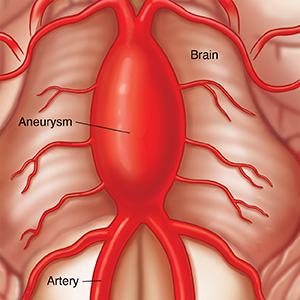Types of Brain Aneurysms
There are several types of brain aneurysms that are classified by shape. These are saccular (also called berry) aneurysms, which are by far the most common. Less common are the fusiform and dissecting types. Brain aneurysms may also be classified by:
-
Size (small, large, and giant)
-
Location
-
Cause (such as a mycotic aneurysm, caused by an infection)
Most aneurysms occur where an artery branches, often at the base of the brain. The risk of an aneurysm bursting (rupturing) can be affected by the shape and location of the aneurysm. The treatment options vary, depending on the type of aneurysm, its size, and its location.
 |
| Using this picture, the surgeon may mark the site of the aneurysm. |
 |
| A saccular (berry) aneurysm bulges from one side of an artery. A neck leads to it. |
 |
| A fusiform aneurysm bulges from all sides of an artery. It rarely has a neck. |
 |
| A giant aneurysm can affect more than one artery. It's over 2.5 centimeters (cm) wide. |
 |
| A mycotic aneurysm is caused by an infected artery wall. This type of aneurysm is fairly rare. |
Online Medical Reviewer:
Chris Southard RN
Online Medical Reviewer:
Marianne Fraser MSN RN
Online Medical Reviewer:
Melinda Murray Ratini DO
Date Last Reviewed:
3/1/2024
© 2000-2025 The StayWell Company, LLC. All rights reserved. This information is not intended as a substitute for professional medical care. Always follow your healthcare professional's instructions.